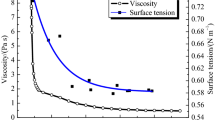The paper examines the effect of ball (drum) grinding and jet milling on the particle size distribution and specific surface area of the powders produced from blast-furnace slag. The effectiveness of jet milling, providing relatively equal powder particles (more than 85% of the fractions is 0–10 μm in size), is shown. Decrease in the average particle size leads to greater specific surface area of the powder and to a sharp increase in activity (strength of the samples prepared with use of blastfurnace slag). Hydraulic activity σ ≥ 30 MPa can be reached by the powder produced from slag with an average particle size to 12 μm and specific surface area S = 0.6–0.8 m2/g, which increases the sample strength. The strength of cemented compositions based on blast-furnace slag can be improved to 40–43 MPa by adding 15–20% Portland cement to the starting mixture.





Similar content being viewed by others

References
M. I. Panfilov, Ya. Sh. Shkol’nik, N. V. Orinskii, et al., Processing of Slag and Wasteless Technology in Metallurgy [in Russian], Metallurgiya, Moscow (1987), p. 237.
G. L. Yagodkin and L. G. Tret’yakov, Chemical Technology and Environmental Protection [in Russian], Znanie, Moscow (1984), p. 63.
V. I. Dovgopol, Use of Ferrous Metallurgy Slag [in Russian], Metallurgiya, Moscow (1978), p. 106.
V. P. Kravchenko and V. A. Strutinskii, “Hydraulic activity of blast-furnace slag,” Stal’, No. 1, 94–95 (2007).
E. G. Avvakumov, Methods of Mechanical Activation of Chemical Processes [in Russian], Nauka, SO AN SSSR, Novosibirsk (1986), p. 305.
Yu. M. Deshko, M. B. Kreimer, and G. S. Krykhtin, Grinding of Materials in Cement Industry [in Russian], Gosstroiizdat, Moscow (1966), p. 271.
A. I. Egurnov, L. Zh. Gorobets, and V. V. Gaevoi, “Assessment of mechanical activation in jet grinding,” Vestn. Nats. Tekh. Univ. Kharkov Politekh. Inst., No. 17, 111–117 (2003).
V. V. Safonov and L. Zh. Gorobets, “Study of nature and mechanical alloying characteristics of ground materials,” in: Construction, Materials Science, and Mechanical Engineering [in Russian], Dnepropetrovsk (2002), Issue 21, pp. 106–110.
V. P. Kravchenko, “Highly active binder materials from blast-furnace slag and methods for their production,” in: Collected Scientific Papers [in Russian], Dnepropetrovsk Nats. Gorn. Univ., Dnepropetrovsk (2011), Issue 4, pp. 20–27.
V. I. Gorobets, L. Zh. Gorobets, A. A. Ivanov, and V. P. Korneev, Jet Mill for Fine Grinding [in Russian], USSR Inventor’s Certificate 294641, IPC6 BO2C19/06, publ. January 1, 1971; Bulletin No. 17, p. 4.
Author information
Authors and Affiliations
Corresponding author
Additional information
Translated from Poroshkovaya Metallurgiya, Vol. 55, Nos. 11–12 (512), pp. 137–144, 2016.
Rights and permissions
About this article
Cite this article
Kravchenko, V.P., Baglyuk, G.A. & Trotsan, A.I. Effectiveness of Jet Milling for Producing Superfine Powders from Blast-Furnace Slag. Powder Metall Met Ceram 55, 745–750 (2017). https://doi.org/10.1007/s11106-017-9863-y
Received:
Published:
Issue Date:
DOI: https://doi.org/10.1007/s11106-017-9863-y



